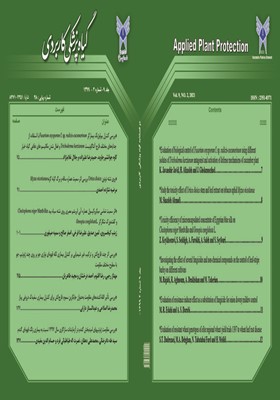بررسی اثر سمیت عصاره ساقه و برگ گیاه گزنه Urtica dioica روی شـته توتـون Myzus nicotianae
محورهای موضوعی : آفات گیاهی
1 - محقق گروه بیوتکنولوژی مرکز تحقیقات و آموزش توتون تیرتاش
کلید واژه: عصاره, گزنه, زیستسنجی, اثر حشرهکشی, شته توتون,
چکیده مقاله :
شته توتون Myzus nicotianae Blackman, 1987 یکی از آفات مهم توتون بوده و به صورت مستقیم و غیر مستقیم، موجب کاهش کمی و کیفی محصول توتون می گردد. امروزه برای کنترل آفات، از انواع حشره کش های شیمیایی استفاده می شود. با توجه به این که عصاره های گیاهی ماندگاری کمی در محیط زیست داشته و سمیت کمی برای انسان، پستانداران و سایر جانداران غیر هدف دارند، جایگزین مناسبی برای اثرات سوء حشره کش های شیمیایی محسوب می شوند. در این تحقیق، خاصیت حشره کشی عصاره برگ و ساقه گیاه گزنه روی شته توتون مورد بررسی قرار گرفت. آزمایشات در دمای 2±25 درجه سلسیوس، رطوبت نسبی 5 ± 70 درصد و دوره نوری 16 ساعت روشنایی و 8 ساعت تاریکی انجام شد. بعد از استخراج عصاره آبی ساقه و برگ گزنه به روش خیساندن، برای انجام آزمایشات زیست سنجی، تعداد 15 عدد حشره کامل بی بال شته روی کاغذ صافی قرار داده شد و اثر کشندگی دو عصاره مذکور در پنج غلظت متفاوت (5/0، 1، 5، 10 و 15 میلی لیتر در لیتر) در چهار تکرار روی درصد تلفات شته توتون مورد بررسی قرار گرفت. غلظت کشنده 50 درصد (LC50) با استفاده از برنامه پروبیت محاسبه شد. نتایج نشان داد که عصاره برگ گزنه با (LC50 = 3/08 mL/L) سمیت بیشتری نسبت به عصاره ساقه گزنه با (LC50 = 5/11 mL/L) داشت. به طوری که کاربرد عصاره برگ گزنه با غلظت 15 میلی لیتر بر لیتر پس از 48 ساعت موجب 100 درصد مرگ و میر در شته توتون شد که در مقایسه با عصاره ساقه گزنه (با 90 درصد مرگ و میر) به طور معنی داری بیشتر بود. در مجموع، نتایج به دست آمده از این تحقیق نشان داد که عصاره هر دو اندام گیاهی به ویژه عصاره برگ گزنه از قدرت خوبی برای کنترل شته توتون برخوردار می باشند.
Tobacco aphid (Myzus nicotianae) is one of the most important pests of tobacco and reduces the quality and quantity the tobacco product, directly and indirectly. Today, chemical insecticides are used to control pests. Due to the fact that plant extracts have a short shelf life in the environment and have low toxicity to humans, mammals and other living organisms, they are a good alternative to the side effects of chemical insecticides. In this study, the insecticidal properties of nettle Urtica dioica leaf and stem extracts on tobacco aphids were investigated. The experiments were performed at a temperature of 25 ±5° C, a relative humidity of 60±5% and a photoperiod of 16L: 8D. After extracting the aqueous extract of nettle by soaking method, for bioassay experiments, the 15 number of adults tobacco aphids were placed on filter paper and the lethal effect of mortality concentrations up to one percent in four replications on tobacco aphids were investigated. The lethal effect of these two extracts at 5 different concentrations (0.5, 1, 5, 10 and 15 mL/L) in four replications on the percentage of tobacco aphid mortality was investigated. The 50% lethal concentration (LC50) was calculated using the Probit program. The results showed that nettle leaf extract with (LC50 = 3.08 mL / L) showed more toxicity than nettle stem extract with (LC50 = 5.11 mL /L). The application of nettle leaf extract with a concentration of 15 mL / L after 48 hours caused 100% mortality on tobacco aphids, which is significantly higher than nettle stem extract (with 90% mortality). Overall, the results of this study showed that the extracts of both plant organs, especially nettle leaf extract, have good power to control tobacco aphids.
_||_

